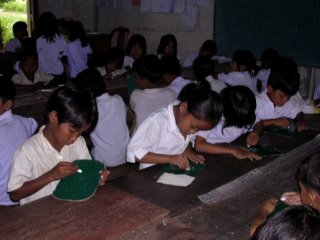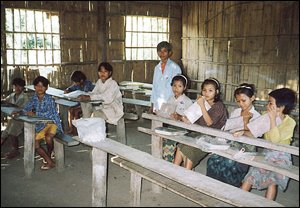Education: A Chronic Issue in Cambodia (By: Sovicheth Boun)
 One of the most fundamental mechanisms for the development of a country is education. Education plays a major role in empowering individuals who will in turn contribute to their country’s socioeconomic and cultural sustainability. By empowering, I mean, education should serve to equip an individual with skills, knowledge and values necessary to develop oneself as a responsible person in the society. “Education is a basic human right, vital to personal and societal development and well being”[1] Over the past decade, access to education for all [Cambodians] has always been a hot issue which attracts a lot of attention from the government, educational institutions, and local and international agencies. The main concern is how we can provide a greater access to education for all Cambodian citizens, especially those disadvantaged and deprived ones who live under the poverty line and in the far-flung areas. There are many reasons which lead to less access to education by those underprivileged groups.
One of the most fundamental mechanisms for the development of a country is education. Education plays a major role in empowering individuals who will in turn contribute to their country’s socioeconomic and cultural sustainability. By empowering, I mean, education should serve to equip an individual with skills, knowledge and values necessary to develop oneself as a responsible person in the society. “Education is a basic human right, vital to personal and societal development and well being”[1] Over the past decade, access to education for all [Cambodians] has always been a hot issue which attracts a lot of attention from the government, educational institutions, and local and international agencies. The main concern is how we can provide a greater access to education for all Cambodian citizens, especially those disadvantaged and deprived ones who live under the poverty line and in the far-flung areas. There are many reasons which lead to less access to education by those underprivileged groups.First, there is a shortage of schools in most parts of Cambodia, especially the rural and remote ones. By shortage, I mean, the number of schools in a particular area doesn’t meet the demand of the population living in that area. Although a number of schools are found to be operating in certain rural and remote areas, however, some of those schools are considered to be disadvantaged schools which do not have good roofs, good floors, good walls, drinking water supply, and latrine facilities (see Table 1). Second, many rural Cambodian rural family cannot afford to send their children to school because their families are financially deprived. As mentioned in the Poverty Profile of Education For All National Plan 2003-2015 (EFA), “Although comparisons between different poverty measures are difficult, the incidence of poverty appears largely unchanged from 1997. Poverty rates are highest in rural areas where roughly 90.5 per cent of the poor live. The remainder of the poor is located in other urban areas (7.2 per cent) and the capital Phnom Penh (2.3 per cent). Average annual income in rural areas was less than one-third of Phnom Penh residents (rural US$ 197 per annum, Phnom Penh US$ 691 per annum).”[2]
Table 1. Education Statistics and Indicators, 2004/2005
PARTICULARS: No. of Schools / Disadv. Schools / No. of Classes
Whole Kingdom: 8,335 / 334 / 78,221
By Area of Location:
By Area of Location:
- Urban Area: 1,047 / 22 / 15,276
- Rural Area: 6,742 / 275 / 60,317
- Remote Area: 546 / 37 / 2,628
(Retrieved October 5, 2006 from
 Moreover, since most of Cambodian people are farmers, they need their children to help with the farming in the field and the household chores. According to a report from Addressing the Education/Poverty Trap, in a recent CSES (Cambodia Socio-Economic Survey) 1999 survey, it was estimated that of the 1.6 million school age children not attending full time, around 25, per cent stated household income/work responsibilities as the primary factor[3]. As a result, many rural children can’t have a chance to go to school. Instead, they have to work in the field with their parents. Finally, security as well as transportation is considered to be a significant deterrent to access to education by those underprivileged groups. Although there are quite a number of schools in many rural and remote areas, many of them are concentrated mainly in the rural towns. So those who live far away from the towns decide not to go to school. Security is another hindrance, particularly for women. Since the school is far from their home, most parents do not allow their daughters to go to school, fearing about their security when commuting to and from school.
Moreover, since most of Cambodian people are farmers, they need their children to help with the farming in the field and the household chores. According to a report from Addressing the Education/Poverty Trap, in a recent CSES (Cambodia Socio-Economic Survey) 1999 survey, it was estimated that of the 1.6 million school age children not attending full time, around 25, per cent stated household income/work responsibilities as the primary factor[3]. As a result, many rural children can’t have a chance to go to school. Instead, they have to work in the field with their parents. Finally, security as well as transportation is considered to be a significant deterrent to access to education by those underprivileged groups. Although there are quite a number of schools in many rural and remote areas, many of them are concentrated mainly in the rural towns. So those who live far away from the towns decide not to go to school. Security is another hindrance, particularly for women. Since the school is far from their home, most parents do not allow their daughters to go to school, fearing about their security when commuting to and from school. Many repercussions have been felt in the society by the issue of a lack of access to education in Cambodia. One of the most common problems is the poverty in the society. Lack of education has led to further deterioration of those families who are already poor. As mentioned in the Poverty Reduction Partnership Agreement, “Cambodia ranks 121st out of 162 countries in the 2001 Human Development Report. Approximately 36% of Cambodia’s population falls below the poverty line. The rural population has substantially lower social indicators than the urban population and poverty is widely distributed through out the country.”[4] This matter of poverty has led to another critical issue which has been, and is still, rife in Cambodia. That is, the child exploitation or abuse and health problem. As stated in an article, Postconflict Issues, “Children are one of the most vulnerable groups in Cambodian society, as evidenced by the child mortality rates. Cambodia's 1997 under-five mortality rate, as reported in the 1999 UN HDR, was the highest in Asia at 167 per 1,000 live births. A major underlying factor is malnutrition. Over 50 percent of children under five are underweight and micronutrient deficiencies are common. Poor children, children from single-headed households, and orphaned and abandoned children who survive early childhood are particularly vulnerable to exploitation as child labor, to sexual exploitation, and to other forms of abuse.”[5] There are many other issues concerned such as social insecurity, crimes, high illiteracy rates, and so on.This journal points out the educational issue in Cambodia regarding the access to education for all Cambodian people. It addresses the rationales behind the issue of lack of access to education and goes on further to reflect the critical repercussions resulting from this hotly-debated issue. The Ministry of Education, Youth and Sports (MoEYS) has strived very hard to tackle the problem. So far there have been a number of strategic plan being implemented by the MoEYS such as Education Strategic Plan (ESP) 2006-10, Education Sector Support Program (ESSP) 2006-10, Expanded Basic Education Program 2006-10, just to name a few. Personally, I believe that in order to get rid of this chronic social problem, concerted efforts from all the stakeholders concerned are vitally essential.
Many repercussions have been felt in the society by the issue of a lack of access to education in Cambodia. One of the most common problems is the poverty in the society. Lack of education has led to further deterioration of those families who are already poor. As mentioned in the Poverty Reduction Partnership Agreement, “Cambodia ranks 121st out of 162 countries in the 2001 Human Development Report. Approximately 36% of Cambodia’s population falls below the poverty line. The rural population has substantially lower social indicators than the urban population and poverty is widely distributed through out the country.”[4] This matter of poverty has led to another critical issue which has been, and is still, rife in Cambodia. That is, the child exploitation or abuse and health problem. As stated in an article, Postconflict Issues, “Children are one of the most vulnerable groups in Cambodian society, as evidenced by the child mortality rates. Cambodia's 1997 under-five mortality rate, as reported in the 1999 UN HDR, was the highest in Asia at 167 per 1,000 live births. A major underlying factor is malnutrition. Over 50 percent of children under five are underweight and micronutrient deficiencies are common. Poor children, children from single-headed households, and orphaned and abandoned children who survive early childhood are particularly vulnerable to exploitation as child labor, to sexual exploitation, and to other forms of abuse.”[5] There are many other issues concerned such as social insecurity, crimes, high illiteracy rates, and so on.This journal points out the educational issue in Cambodia regarding the access to education for all Cambodian people. It addresses the rationales behind the issue of lack of access to education and goes on further to reflect the critical repercussions resulting from this hotly-debated issue. The Ministry of Education, Youth and Sports (MoEYS) has strived very hard to tackle the problem. So far there have been a number of strategic plan being implemented by the MoEYS such as Education Strategic Plan (ESP) 2006-10, Education Sector Support Program (ESSP) 2006-10, Expanded Basic Education Program 2006-10, just to name a few. Personally, I believe that in order to get rid of this chronic social problem, concerted efforts from all the stakeholders concerned are vitally essential.[1] Basic Education and Gender Equality. (n.d.) Retrieved October 5, 2006,
from http://www.moeys.gov.kh/en/education/efa/poverty_profile.htm
[3] Addressing the Education/Poverty Trap. (n.d.) Retrieved October 05, 2006
[3] Addressing the Education/Poverty Trap. (n.d.) Retrieved October 05, 2006
from http://www.moeys.gov.kh/en/education/efa/addressing_education.htm
[4] Poverty Reduction Partnership Agreement. (n.d.) Retrieved October 05, 2006
[4] Poverty Reduction Partnership Agreement. (n.d.) Retrieved October 05, 2006
from http://www.adb.org/Documents/Poverty/pa_cam.pdf
[5] Postconflict Issues. (n.d.) Retrieved October 05, 20006
[5] Postconflict Issues. (n.d.) Retrieved October 05, 20006
